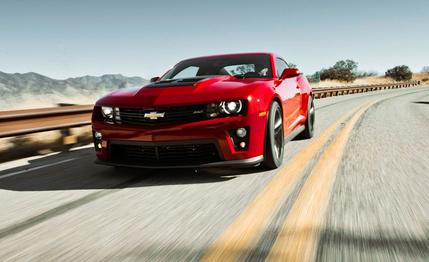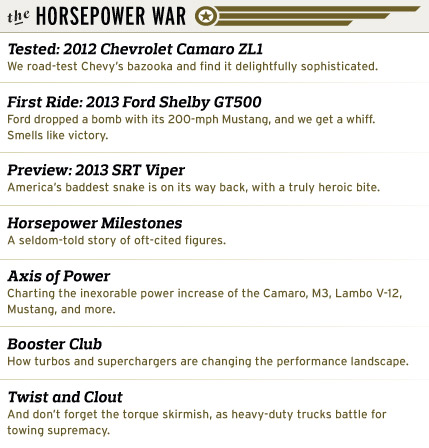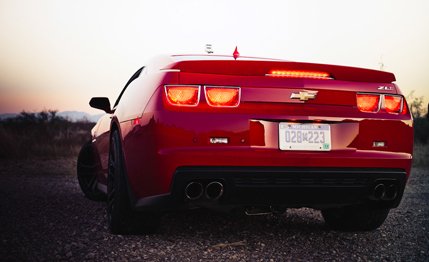
 Instrumented Test
Instrumented Test






Midway down the main straight at Inde Motorsports Ranch outside Tucson, Arizona, the shift lights on the head-up display flash. At 106 mph, we grab fourth gear, and another wave of ferocious acceleration propels the car forward. We graze 130 mph before hitting the brakes and downshifting for Turn Three, a fast right-hand sweeper that puts the coupe’s stability—and our own intestinal fortitude—to the test. As soon as we get back on the throttle and glance at the windshield-projected speed, we’re already doing 110.
The car in this scenario is the new Chevrolet Camaro ZL1, the long-rumored, much-hyped Killer Camaro. It features GM’s second-most-powerful engine: With 580 horsepower, it’s behind only the truly absurd, 638-hp Corvette ZR1. No surprise that during its development it was known simply as the “HP.” And it carries the most sophisticated adjustable dampers and stability-control system any amount of money can buy. For this, GM asks a base price of $56,295, which includes a $1300 gas-guzzler tax; all the go-fast parts are standard issue.
The ZL1 is not your old-school, all-ate-up-with-motor muscle car, although its name derives from such a vehicle. It is built with the GM Performance Division mantra of “go, stop, and turn” in mind. Track ability was always part of the HP program from back when everyone assumed the car would be called the Z28. But highlighting that point is more important now that Ford stole GM’s big, SAE-net thunder by announcing the 650-hp 2013 Shelby GT500. Having already placed second in the realm of public perception and internet-forum keyboard racing, the ZL1 needs to be about more than just straight-line speed.


Which is not to say the ZL1 neglects single-vector velocity. Top speed is a claimed 180 mph with the manual transmission. With 580 horsepower and 556 pound-feet of torque from the supercharged 6.2-liter LSA V-8, eye-popping acceleration is also a given despite the ZL1’s hefty 4120-pound curb weight. The engine is carried over from the CTS-V, with a two-stage exhaust system borrowed from the Corvette and a revised intake responsible for the extra 24 horsepower. Two bits of technology aid in the quarter-mile fight: “No-lift shift” allows you to crack off upshifts without easing off the gas, and launch control manages wheelspin and helps 0-to-60 consistency (although we were able to beat the system after a few attempts). Get everything right, and the ZL1 hits 60 mph in 4.1 seconds and passes 1320 feet in 12.3 seconds at 119 mph—or better, as the cold and dusty track at Inde was less than ideal for acceleration runs. Few cars costing less than $60,000 can claim such feats. And the ZL1 sounds angry, with a throaty bass-boat rumble backed by a faint supercharger whine. The V-8 fires up with a roar, and the exhaust crackles when you back out of full throttle.


Thirty percent of the parts in the ZL1 are new or reengineered, says Camaro chief engineer Al Oppenheiser. New, third-generation magnetorheological shocks control the 20-inch forged-aluminum wheels and Goodyear Eagle F1 SuperCar G: 2 tires (which together save 22 pounds of unsprung weight versus the Camaro SS). A strut-tower brace spans the engine bay, and the rear anti-roll bar is attached to the suspension farther outboard (a change folded back into the 2012 SS). The brakes use the same calipers as the CTS-V but have two-piece rotors that perform slightly better, though they’re a bit noisier than the twin-cast discs in the Cadillac.
Unlike the rest of the Camaro lineup, the ZL1 has electrically assisted power steering (EPS). The unit found here can differentiate between forces on the front wheels and those coming from the helm, and it accordingly stifles any kickback. We suspect the EPS system also dampens some steering feel, but we drove a Camaro SS around the track shortly before sampling the ZL1; had we not been told about the electric boost, it would be hard to tell the difference.
Starker is the transformation of the ZL1’s handling characteristics from those of a stock SS. In the latter, the driver is always fighting the car—it understeers on turn-in and oversteers on corner exit, all served up with a healthy dollop of body roll. The ZL1 does exactly what you want all the time, with no surprises. Front grip is tenacious enough that you actually get a sense of the tires biting in as you turn the wheel. Power comes in so creamily and with such linearity that it’s easy to forget you’re driving a 580-hp car. The brake pedal feels solid but still offers enough travel for smooth application, and it shows no fade. The ZL1 goes around the track with a composure that would shock many BMW M3 fans. Our only complaint is that the seat, adequate in the SS, lacks the lateral support to cope with the ZL1’s higher limits. We saw 0.98 g on a dusty skidpad (did we mention Tucson is in the desert?). This is supercar territory.

